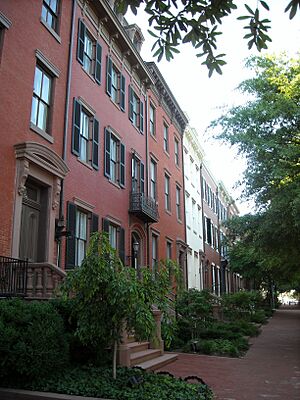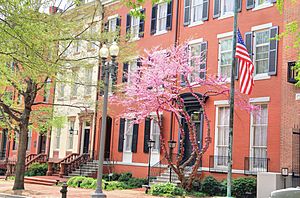Jackson Place facts for kids
Jackson Place is a street in Washington, D.C. It's right across from the White House and forms the western edge of Lafayette Square. This important street runs between Pennsylvania Avenue and H Street, NW.
Contents
- History of Jackson Place
- Buildings on Jackson Place
- Peter Parker House
- 704 Jackson Place
- Trowbridge House
- 712 Jackson Place
- 716 Jackson Place: The Presidential Townhouse
- 718 Jackson Place
- 722 Jackson Place
- 726 Jackson Place: White House Conference Center
- 730 Jackson Place
- 734 Jackson Place: American Peace Society House
- 736 Jackson Place
- 740–744 Jackson Place
- Decatur House
- Ewell House (Demolished)
- Images for kids
History of Jackson Place
The land where Jackson Place is located was once owned by the Decatur family. In 1957, the U.S. government bought the townhouses on Jackson Place. The government planned to tear down these buildings to build a new office building.
However, in 1962, First Lady Jacqueline Kennedy stepped in. She helped stop the project, saving the historic buildings.
Buildings on Jackson Place
Jackson Place is lined with several townhouses. Most of these were built in the late 1800s.
Peter Parker House
The Peter Parker House (700 Jackson Place) was built in 1860. It's on the corner with Pennsylvania Avenue. A doctor named Peter Parker was one of its first residents. For many years, it was home to the Carnegie Endowment for International Peace. In the 1980s, it became part of Blair House.
704 Jackson Place
This building was also joined with Blair House in the 1980s.
Trowbridge House
The Trowbridge House (708 Jackson Place) was built in 1859. Since the early 1900s, the government has used it for offices. It is now being added to the Blair House complex.
712 Jackson Place
This building was built in 1869. It was once owned by Henry Rathbone, who was with President Abraham Lincoln at Ford's Theatre. During World War I, it housed the Committee for Public Information. For a short time, it was also home to the Women's International League for Peace and Freedom. Today, it is home to the White House Fellows program and the Harry S. Truman Scholarship Foundation.
716 Jackson Place: The Presidential Townhouse
The building at 716 Jackson Place is owned by the U.S. Government. It is used by former Presidents when they visit Washington, D.C. It was bought in the late 1950s. In 1969, President Richard Nixon officially named it the "Presidential Townhouse." President George W. Bush later helped furnish it using private donations. This five-story building has two dining rooms, many bedrooms, and space for the Secret Service in the basement.
718 Jackson Place

718 Jackson Place NW was once the main office for the Congress of Industrial Organizations (CIO). This group later joined with another to form the AFL-CIO. As of 2008, the government owns this building. It houses small groups that work with the Executive Office of the President.
722 Jackson Place
This building was once the headquarters of the National Woman's Party (NWP). This was during the time of the Silent Sentinels. These were protests held outside the White House for over two years, asking for women's right to vote. It was also the home of the Council on Environmental Quality for a long time.
726 Jackson Place: White House Conference Center
From August 2006 to July 2007, 726 Jackson Place was used as a temporary press briefing room for the White House. This was while the regular James S. Brady Press Briefing Room was being renovated.
730 Jackson Place
730 Jackson Place is used for federal offices. The Council on Environmental Quality is one of the groups that has offices here.
734 Jackson Place: American Peace Society House
734 Jackson Place is a National Historic Landmark. This means it's a very important historic building. It was the main office for the American Peace Society from 1911 to 1946. In the 1970s, it was combined with a nearby building. It then housed the offices for the group celebrating the 200th birthday of the American Revolution.
736 Jackson Place
This townhouse was built around 1870. Many important people lived here, including Michigan Representative John Stoughton Newberry and Senator James G. Blaine.
In 1902, President Theodore Roosevelt and his team used this townhouse as a temporary office. This was while the White House was being renovated. On October 3, 1902, Roosevelt held an important meeting here. He discussed a large anthracite coal strike happening in Pennsylvania.
Later, the Women's City Club of Washington bought the townhouse. Today, it houses the United States Digital Service.
740–744 Jackson Place
These buildings are home to the White House Historical Association.
Decatur House
Benjamin Henry Latrobe designed the Decatur House, located at 748 Jackson Place. It was finished in 1818 for naval hero Stephen Decatur and his wife. Its beautiful design and location across from the White House made it a very popular address. Many famous people lived here, including Henry Clay and Martin Van Buren. The Decatur House is now owned by the National Trust for Historic Preservation. It is used as a museum by the White House Historical Association.
Ewell House (Demolished)
The Ewell House was built on Jackson Place in 1819 for Dr. Thomas Ewell. He was a doctor in the city and wrote a popular medical book. Many government officials lived in this house over the years. These included Smith Thompson, Samuel Southard, John Berrien, and Vice President Schuyler Colfax. This house has since been torn down.
Images for kids
-
Peter Parker House, 700 Jackson Place, and adjoining 704 Jackson Place
-
American Peace Society house, 734 Jackson Place
-
Decatur House, 748 Jackson Place




















